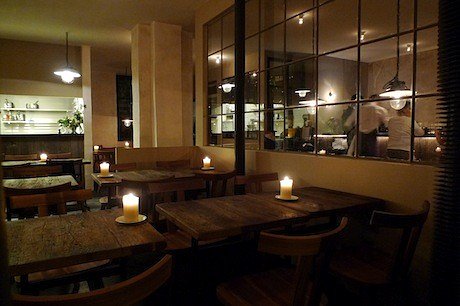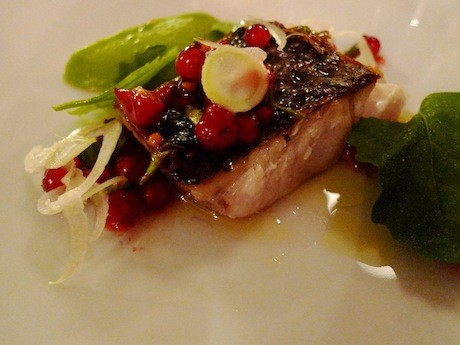Septime

Wed 3 Aug 2011

Septime
80, rue de Charonne, in the 11th Arrondissement.
Lunch, Tues–Fri; dinner, Tues–Sat. 01 43 67 38 29.
For superb contemporary cooking, Septime is the Paris restaurant to book.
Chef Bertrand Grébaut went into business in late spring with grant money from Evian, which aptly deemed him a promising talent after time spent at L’Arpège and Agapé, where he gained one Michelin star. He’s still not even 30.
That’s a high-end résumé, but like many before him, Grébaut chose a low-key, lower-rent part of town to set up shop, in this case the 11th, where he’s in good company (Rino is nearby, for one).
A very pretty bar with antique taps and a long communal table fill the first room. Behind that is a nook with a few tables facing an interior courtyard. On the other side of a windowed wall is the main dining room, with the open kitchen at the back. There’s lots of wood, glass and brick, fused into a kind of rustic-industrial chic; this Paris restaurant could be in New York, London or Copenhagen.
The first thing I ate here was a fat spear of white asparagus with sauce gribiche, which on paper sounds almost old fashioned. But what arrived was not: the gribiche was infused with oyster and watermelon-colored roe, and tiny leaves and flowers were strewn across the dish. It was a delicious distillation of Grébaut’s style, which reflects the current obsession with pristine product, no small amount of Nordic influence (several dishes have been strongly reminiscent of things I had at Noma, the renowned Copenhagen restaurant) and a strong thread of classic technique, sometimes more visible than others.
My last meal began with dewy raspberries, served whole on top of their own granité, with raw favas, young almonds and curds of very fresh cheese. Next was a crystal-clear, intense bouillon garnished with a few leaves of tarragon and crowned with a perfect wobbly egg.
The fish course was a seared fillet of maigre swimming in a tart sauce of red currants and shaved fennel bound by golden green olive oil. Pigeon, red and rare, was served with shaved raw beets and bitter Treviso atop a smear of beet and red currant sauce. Dessert was a refreshing passionfruit sorbet accompanied by a perfectly silky ganache, slightly bitter and sweet with caramel.

Maigre with red currants and fennel.
Grébaut’s cooking is definitely light on starch, though his gnocchetti—miniature gnocchi—are superb. I had them the first time (with an aged Gouda and deep yellow corn cream) but not the second, and missed them a little bit. If gnocchetti are on the menu, order them.
I’ve been to Septime twice (three times if you count a glass of wine I had late one evening to wash out the bad taste of a disappointing meal at another spot in the neighborhood). Each time I was struck by the service, which is professional but calm. Not casual: calm, with not one iota of the you’re-lucky-to-be-here attitude found at other of-the-moment Paris restaurants, even though we were. Lucky to be there, I mean. This is not an easy reservation, partly because the prices are so reasonable: at lunch, there are two- and three-course menus priced at 21 and 26 euros. At dinner, plan on spending 40–50 euros for three courses, or go for the 55 euro five-course “carte blanche” menu, an extraordinary value for cooking this good.
Months ago I read an interview in which Grébaut said he wanted to “democratize haute cuisine,” which struck me then as a little pretentious. But I think he’s succeeded.
In a nutshell: Septime offers high-end, high-caliber contemporary cooking in a beautiful, relaxed setting at great prices.
Price check: Lunch menus at 21 and 26 euros; dinner, 40–50 euros à la carte (55 euros for the tasting menu). Wines run the gamut.
If Septime sounds good but you can’t get in, try Saturne, another showcase of hypernatural, modern French cooking. Read the review.
Saturne
17, rue Notre Dame des Victoires, in the 2nd.
Lunch and dinner, Mon–Fri. 01 42 60 31 90.
Editor’s note: For a gourmet walking trip, check out our DIY downloadable trips.